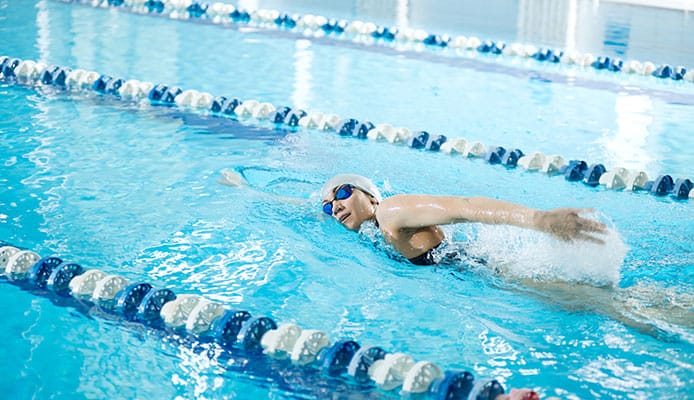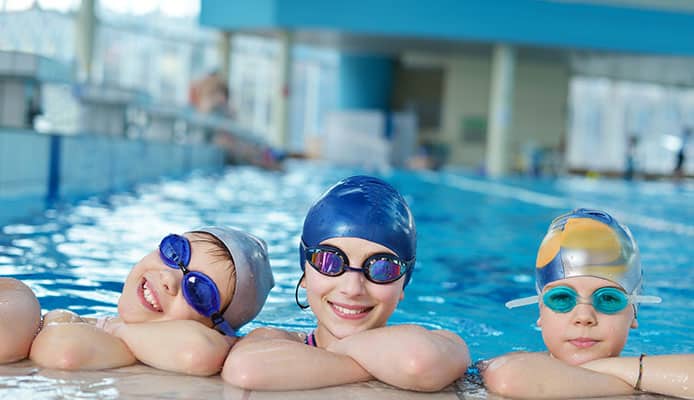
When a rush of urgency overcomes a laboring body during a swim, it’s best to listen to those internal messages advising you to do what keeps you safe and take that breath you need to replenish your oxygen intake. Imagine bypassing those high-intensity moments of depleted oxygen levels in the water by harnessing the ability to increase your lung capacity while swimming. Here are some tips that could help you achieve a more controlled and beneficial swimming session:
Extend Your Breathing
Make sure that before you enter any body of water you have taken long exhalation and inhalation breathes through your windpipe to exercise your lungs. Before swimming, maintain consistent, controlled breathing to ensure that your lung passages will provide maximum performance. Taking the first leap into the water should always be accompanied by completely air-filled lungs. Inhale oxygen to your deepest reserves so you have air to sustain you while swimming; this will also create buoyancy in the body so you can easily approach the surface of the water to take in more air when all the oxygen has been used.
Strategic Air Intake
To increase lung capacity, try challenging yourself from the outset but always be aware of your limitations. If swimming in a lap pool with lanes set the bar at its highest and attempt a wall-to-wall underwater swim. Focus on streamlining through the water without exerting too much energy to conserve air within the body. Once you reach the other side, reward yourself with 30 seconds to a minute of breath time to restock your lungs and stabilize your breathing. If swimming the full distance to the other side without taking a breath isn’t feasible, try going for as long as your body is comfortable with it and ensure that when you surface for air, you quickly exhale any lingering air and take in a full supply of oxygen.
Directing Body Movement
A cardiovascular workout as laborious as swimming requires swimmers to understand how to move in the water to capitalize on the workout’s benefits. Swimmers can start by decreasing leg movement in the quadriceps, which usurp the most oxygen and kicking lightly throughout the swim session. When kicking off the wall, keep your arms and legs still and avoid any movement until the body starts to slow down in the water. At this point begin whichever stroke you prefer and focus on swimming form.
Designed Breathing
Breathing patterns can serve as an advantage if you’re not comfortable with holding your breath for long underwater. In freestyle form, it’s easy to set goals by taking breathes every set number of strokes. For example, you could start by taking in the air every five strokes and work your way up to every seven or nine strokes, depending on your style and comfortability. By challenging yourself and alternating different lengths of time sustaining your breath underwater, your lung capacity will start to increase and become accustomed to the extended stretches in holding your breath. Be advised that a slight burning sensation in your lungs is normal when practicing breath control. Lactic acid is produced in the body when people hold their breath, which results in a burning feeling.
Take Your Time
Despite engaging in quick-moving activity, it’s fundamental that swimmers exhale slowly when doing no-breathers (holding your breath until the end of the lap). By regulating your breathing instead of hyperventilating, you will avoid oxygen depletion while swimming. Blowing out carbon dioxide from your lungs and inhaling oxygen too quickly could demand your body take in a breath when it’s not ready to and disrupt a controlled pattern of breathing. After reading these tips and gaining a sense of eagerness within your aquatic being, make sure you don’t overdo it. Sprinting to the other side at the beginning of the lap instead of finding a steady pace during the set will exhaust energy and oxygen levels at an accelerated rate. It’s better to gradually build up your lung capacity by applying the various methods detailed here.
Butterfly Stroke
Some swimmers find the butterfly stroke easier to execute no-breathers. Due to minimal leg exertion during this mostly upper-body workout, oxygen can be utilized in the lungs and head instead of the lower body. Although this stroke isn’t the most natural way to move through the water, it’s worth trying in the quest to increase lung capacity.
You might also like: Difference Between A Training Suit And Technical Race Suit
Understanding Timeframes

It’s important to recognize that any natural change to the body takes time, thus, don’t expect your lung capacity to increase after the first day (or even the first week) after applying these tips. It’s important to listen to your body and know how far to push yourself without creating a dangerous or potentially severe situation while swimming. If feeling light-headed then recognize the warning signs and bring yourself to a safe place. Put yourself at ease by always swimming in an area with a lifeguard or someone monitoring swimmers. Ingesting water and getting it down your windpipe can cause you to lose your ability to surface for air, so you must be in control at all times.
Globo Surf Overview
Swimming is one of the most comprehensive workouts a person can do and isn’t so taxing on the joints and muscles. To optimize the experience while swimming, try to glide through the water and smooth out your stroke. Eliminating any excess movement and keeping a steady pace will aid in increasing lung capacity because the body will not have to compensate for the extra activity. If swimming in a pool, the feeling of launching yourself from the edge of the wall will become a moment of power, initiating the challenge to function with the air reserved in the body and exercising your lungs to inhale and exhale on command. By discovering tools to increase lung capacity for swimming such as the ones in this article, you can take control of your body and instruct it to deliver its peak performance. That will not only serve you in the water, but you will also find yourself taking more mindful breathes in everyday life and when resting your body.

